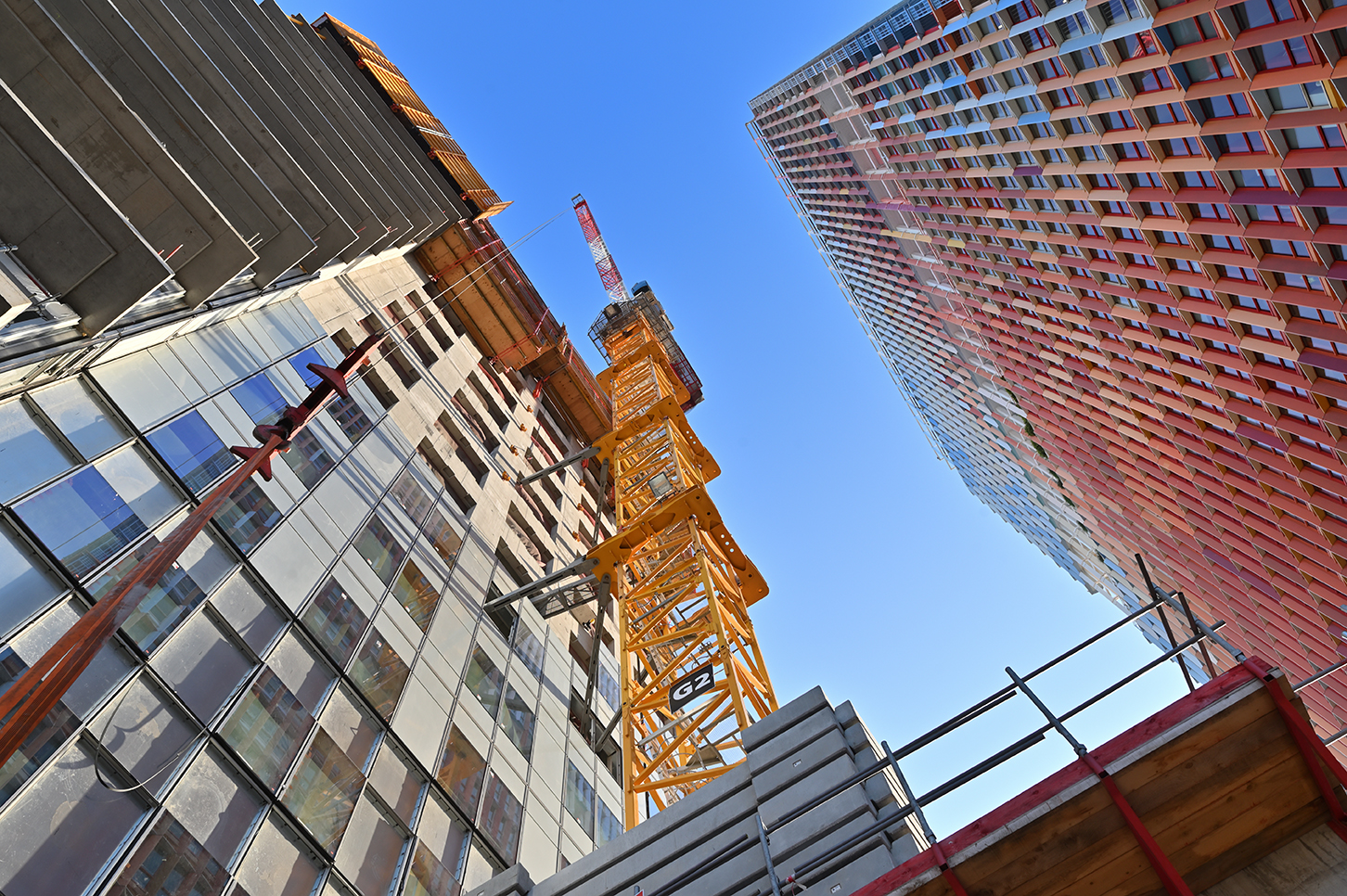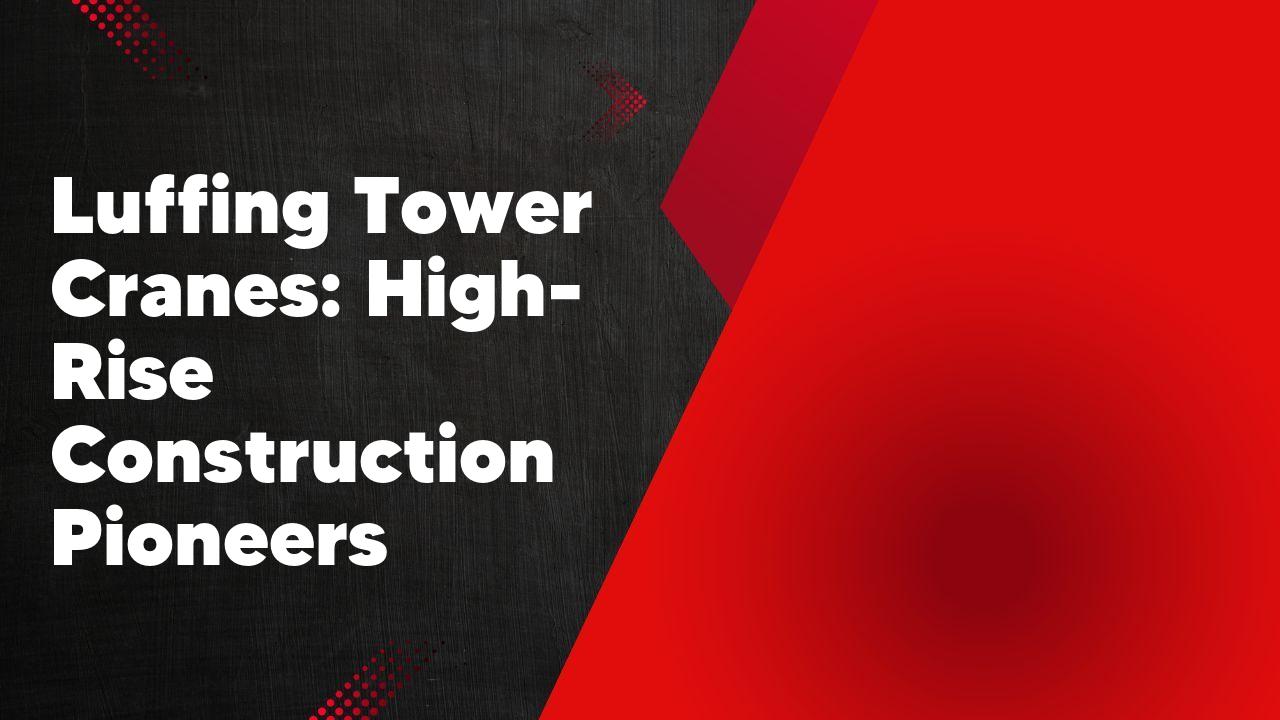Luffing tower cranes have revolutionized the high-rise construction industry, allowing for greater efficiency and safety on job sites. These towering machines are capable of reaching incredible heights and lifting heavy loads with precision and ease. In this article, we will explore the history and development of luffing tower cranes and their impact on modern construction practices.
The Evolution of Luffing Tower Cranes in High-Rise Construction
Luffing tower cranes have undergone significant evolution in high-rise construction. These cranes are specifically designed to work in tight spaces and handle heavy loads at great heights. In the past, traditional tower cranes were used, but they had limitations in terms of height and reach. Luffing tower cranes have solved these issues by incorporating a luffing jib that allows for greater flexibility and maneuverability. This jib can be adjusted to different angles, enabling the crane to work efficiently in confined spaces. Additionally, advancements in technology have led to the development of more powerful and efficient luffing tower cranes, further enhancing their capabilities in high-rise construction projects.
Advantages and Benefits of Using Luffing Tower Cranes in High-Rise Projects

Luffing tower cranes offer several advantages and benefits when it comes to high-rise projects. Firstly, these cranes have a smaller footprint compared to other types of cranes, making them ideal for congested construction sites. This allows for better utilization of space and increased efficiency. Additionally, luffing tower cranes have a higher lifting capacity, enabling them to handle heavier loads at greater heights. This makes them suitable for tall buildings and skyscrapers. Moreover, these cranes have a luffing jib that can be adjusted to different angles, allowing for precise and controlled lifting operations. Overall, the use of luffing tower cranes in high-rise projects can significantly improve productivity and safety on the construction site.
Key Features and Components of Luffing Tower Cranes for High-Rise Construction
Luffing tower cranes are essential equipment in high-rise construction projects. These cranes are designed to handle heavy loads and operate in tight spaces. One key feature of luffing tower cranes is their ability to luff or pivot the jib, allowing for precise positioning of materials. This is especially important in congested urban areas where space is limited. Another important component of these cranes is the counterweight system, which helps to balance the load and ensure stability. Luffing tower cranes also have advanced safety features such as anti-collision systems and overload protection. Overall, these cranes play a crucial role in the efficient and safe construction of tall buildings.
Safety Considerations and Regulations for Luffing Tower Cranes in High-Rise Projects
Safety is of utmost importance in any construction project, especially in high-rise projects where the risks are amplified. Luffing tower cranes play a crucial role in these projects, but their operation requires strict adherence to safety considerations and regulations. Firstly, it is essential to ensure that the crane is properly installed and maintained to prevent any structural failures or accidents. Additionally, the crane operator must be highly trained and experienced to handle the complexities of luffing tower cranes. Safety measures such as regular inspections, proper signaling, and clear communication between the crane operator and other workers are also vital. Finally, compliance with local regulations and industry standards is necessary to ensure the safe operation of luffing tower cranes in high-rise projects.
Case Studies: Successful Implementation of Luffing Tower Cranes in High-Rise Construction
Luffing tower cranes have proven to be a successful choice for high-rise construction projects, as demonstrated by several case studies. These cranes offer numerous advantages, including their ability to work in tight spaces and their high lifting capacities. One case study involved the construction of a 50-story residential building in a densely populated urban area. The luffing tower crane was able to navigate through narrow streets and lift heavy materials to great heights, ensuring efficient construction progress. Another case study focused on a 60-story office tower, where the luffing tower crane played a crucial role in the timely completion of the project. These case studies highlight the effectiveness and reliability of luffing tower cranes in high-rise construction.
Future Trends and Innovations in Luffing Tower Cranes for High-Rise Building Projects
The future of luffing tower cranes for high-rise building projects is set to be filled with exciting trends and innovations. One of the key trends is the use of advanced technology, such as automation and remote control systems, to enhance the efficiency and safety of these cranes. This technology allows for precise and accurate positioning of the crane, reducing the risk of accidents and improving productivity. Another trend is the development of lighter and more compact cranes, which can be easily transported and assembled on-site. This not only saves time and costs but also allows for greater flexibility in construction projects. Additionally, there is a growing focus on sustainability, with the introduction of eco-friendly features and energy-efficient systems in luffing tower cranes. These innovations aim to reduce the environmental impact of construction projects while still meeting the demands of high-rise building projects. Overall, the future of luffing tower cranes looks promising, with advancements in technology, design, and sustainability paving the way for more efficient and environmentally-friendly construction practices.
Conclusion
In conclusion, luffing tower cranes have revolutionized high-rise construction by offering increased flexibility and efficiency. Their ability to work in tight spaces and navigate around obstacles makes them ideal for urban construction projects. As the demand for taller and more complex buildings continues to grow, luffing tower cranes will play a crucial role in shaping the skylines of cities around the world.
What are luffing tower cranes?
Luffing tower cranes are specialized construction cranes that are commonly used in high-rise construction projects. Unlike traditional tower cranes, luffing cranes have a variable jib angle, allowing them to work in tight spaces and avoid obstacles.
How do luffing tower cranes differ from traditional tower cranes?
Luffing tower cranes differ from traditional tower cranes primarily in their ability to change the jib angle. This feature allows luffing cranes to work in confined spaces and avoid obstacles, making them ideal for high-rise construction projects.
What are the advantages of using luffing tower cranes?
There are several advantages to using luffing tower cranes. Firstly, their variable jib angle allows them to work in tight spaces and avoid obstacles, making them highly versatile. Additionally, luffing cranes have a higher lifting capacity compared to traditional tower cranes, making them suitable for heavy lifting in high-rise construction.
Are luffing tower cranes more expensive than traditional tower cranes?
Yes, luffing tower cranes are generally more expensive than traditional tower cranes. This is due to their specialized design and additional features, such as the ability to change the jib angle. However, the increased versatility and lifting capacity of luffing cranes can often justify the higher cost in high-rise construction projects.
What safety precautions should be taken when operating luffing tower cranes?
When operating luffing tower cranes, it is important to follow strict safety protocols. This includes ensuring that the crane is properly maintained and inspected regularly, using trained and certified operators, and adhering to all relevant safety regulations. Additionally, proper communication and coordination with other workers on the construction site is crucial to prevent accidents.
Can luffing tower cranes be used in other types of construction projects?
While luffing tower cranes are commonly used in high-rise construction projects, they can also be utilized in other types of construction projects where space is limited or obstacles need to be avoided. Their versatility and ability to work in confined spaces make them suitable for various construction applications.

